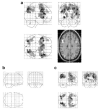Acute ketamine administration alters the brain responses to executive demands in a verbal working memory task: an FMRI study
- PMID: 15100698
- PMCID: PMC3838946
- DOI: 10.1038/sj.npp.1300438
Acute ketamine administration alters the brain responses to executive demands in a verbal working memory task: an FMRI study
Abstract
We have used functional MRI to determine the effects of ketamine on brain systems activated in association with a working memory task. Healthy volunteers received intravenous infusions of placebo, ketamine at 50 ng/ml plasma concentration, and ketamine at 100 ng/ml. They were scanned while carrying out a verbal working memory task in which we varied the executive requirements (manipulation vs maintenance processes) and the mnemonic load (three vs five presented letters). We previously showed that ketamine produces a specific behavioral impairment in the manipulation task. In the current study, we modified tasks in order to match performance across drug and placebo conditions, and used an event-related fMRI design, allowing us to remove unsuccessful trials from the analysis. Our results suggest a task-specific effect of ketamine on working memory in a brain system comprising frontal cortex, parietal cortex, and putamen. When subjects are required to manipulate presented letters into alphabetical order, as opposed to maintaining them in the order in which they were presented, ketamine is associated with significantly greater activity in this system, even under these performance-matched conditions. No significant effect of ketamine was seen in association with increasing load. This suggests that our findings are not explicable in terms of a nonspecific effect of ketamine when task difficulty is increased. Rather, our findings provide evidence that the predominant effects of low, subdissociative doses of ketamine are upon the control processes engaged by the manipulation task. Furthermore, we have shown that ketamine's effects may be elucidated by fMRI even when overt behavioral measures show no evidence of impairment.
Copyright 2004 Nature Publishing Group
Figures




Similar articles
-
The effects of a subpsychotic dose of ketamine on recognition and source memory for agency: implications for pharmacological modelling of core symptoms of schizophrenia.Neuropsychopharmacology. 2006 Feb;31(2):413-23. doi: 10.1038/sj.npp.1300846. Neuropsychopharmacology. 2006. PMID: 16123767 Free PMC article. Clinical Trial.
-
Subdissociative dose ketamine produces a deficit in manipulation but not maintenance of the contents of working memory.Neuropsychopharmacology. 2003 Nov;28(11):2037-44. doi: 10.1038/sj.npp.1300272. Neuropsychopharmacology. 2003. PMID: 12888783 Free PMC article. Clinical Trial.
-
A randomized, placebo-controlled, phase 1 study to evaluate the effects of TAK-063 on ketamine-induced changes in fMRI BOLD signal in healthy subjects.Psychopharmacology (Berl). 2020 Feb;237(2):317-328. doi: 10.1007/s00213-019-05366-1. Epub 2019 Nov 26. Psychopharmacology (Berl). 2020. PMID: 31773211 Free PMC article. Clinical Trial.
-
Processing efficiency of a verbal working memory system is modulated by amphetamine: an fMRI investigation.Psychopharmacology (Berl). 2005 Aug;180(4):634-43. doi: 10.1007/s00213-005-0025-4. Epub 2005 Sep 14. Psychopharmacology (Berl). 2005. PMID: 15983790 Clinical Trial.
-
Cognitive and subjective acute dose effects of intramuscular ketamine in healthy adults.Exp Clin Psychopharmacol. 2006 Nov;14(4):439-49. doi: 10.1037/1064-1297.14.4.439. Exp Clin Psychopharmacol. 2006. PMID: 17115871 Clinical Trial.
Cited by
-
Effects of ketamine on brain function during smooth pursuit eye movements.Hum Brain Mapp. 2016 Nov;37(11):4047-4060. doi: 10.1002/hbm.23294. Hum Brain Mapp. 2016. PMID: 27342447 Free PMC article. Clinical Trial.
-
The thalamus in psychosis spectrum disorder.Front Neurosci. 2023 Apr 13;17:1163600. doi: 10.3389/fnins.2023.1163600. eCollection 2023. Front Neurosci. 2023. PMID: 37123374 Free PMC article.
-
Effects of Ketamine and Midazolam on Simultaneous EEG/fMRI Data During Working Memory Processes.Brain Topogr. 2021 Nov;34(6):863-880. doi: 10.1007/s10548-021-00876-8. Epub 2021 Oct 13. Brain Topogr. 2021. PMID: 34642836 Clinical Trial.
-
The effects of a subpsychotic dose of ketamine on recognition and source memory for agency: implications for pharmacological modelling of core symptoms of schizophrenia.Neuropsychopharmacology. 2006 Feb;31(2):413-23. doi: 10.1038/sj.npp.1300846. Neuropsychopharmacology. 2006. PMID: 16123767 Free PMC article. Clinical Trial.
-
Effects of Ketamine on Frontoparietal Interactions in a Rule-Based Antisaccade Task in Macaque Monkeys.J Neurosci. 2024 Dec 11;44(50):e1018232024. doi: 10.1523/JNEUROSCI.1018-23.2024. J Neurosci. 2024. PMID: 39472063 Free PMC article.
References
-
- Adler CM, Goldberg TE, Malhotra AK, Pickar D, Breier A. Effects of ketamine on thought disorder, working memory, and semantic memory in healthy volunteers. Biol Psychiatry. 1998;43:811–816. - PubMed
-
- Baddeley AD. Working Memory. Clarendon Press; Oxford, UK: 1986.
-
- Baddeley AD, Hitch GJ. Developments in the concept of working memory. Neuropsychology. 1994;8:485–493.
-
- Braver TS, Cohen JD, Nystrom LE, Jonides J, Smith EE, Noll DC. A parametric study of prefrontal cortex involvement in human working memory. Neuroimage. 1997;5:49–62. - PubMed
Publication types
MeSH terms
Substances
Grants and funding
LinkOut - more resources
Full Text Sources

